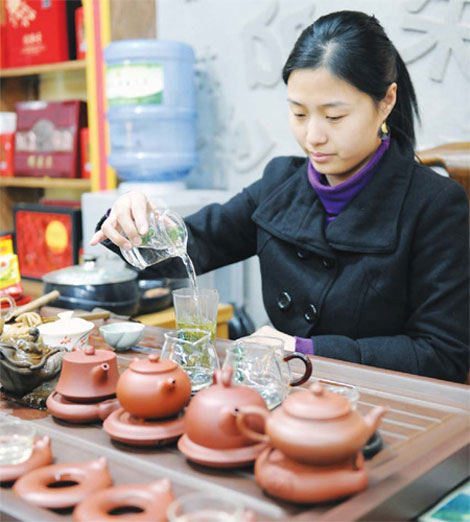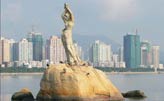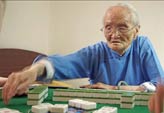Economy
Tea-ing up
Updated: 2011-03-25 10:42
By Ben Yue (China Daily European Weekly)
 |
|
A saleswoman makes green tea for customers at a tea business in Maliandao, the biggest tea business street in southern Beijing. Green tea produced before the Tomb Sweeping Festival, on April 5, is believed to be the most expensive across an entire year's sales. Prices for green tea products, especially from plants grown in East China's Zhejiang province, are rising this year. Wang Yuanzheng / for China Daily |
More turning to Chinese tea for investment opportunities like vintage wine
While many rich Chinese people are happy to fork out $2,000 (1,420 euros) on a bottle of Chateau Lafite-Rothschild, one of the most expensive wines in the world, others are turning to a more traditional Chinese beverage with centuries of culture behind it.
Rare and exotic teas are fast developing into investment opportunities with the marketing potential that French vintage wines have possessed for decades.
Xinhua News Agency reported futures in the best quality longjing (or Dragon Well) spring tea, the leaves of which will be picked in early March, have already sold out at 60,000 yuan (6,496 euros) a kilogram.
The teas are mainly given as presents to businessmen and officials after being packaged into a luxury product, according to Zhu Baichang, president of Hangzhou Longjing Tea Group.
The price of longjing has boosted expectations for this year's spring tea market. Experts say the average price set by farmers might be up 15 percent because of high demand, unusual weather that has improved quality and soaring labor costs. For some specific brands, the retail price could increase more than 50 percent.
Spring is the crucial season for the tea business. Tea that matures then is of the highest quality thanks to low temperatures and dry conditions. Research by the China Tea Marketing Association (CTMA) shows that the trade in spring tea occupies 75 percent of the entire year by value, although it consists of only 39 percent of the year's production by volume.
In Beijing's Maliandao Tea Street, the biggest tea trade hub in southern Beijing, business is getting busier day by day.
"We have to delay our closing time from 6 pm to 8 pm from this week (from March 21)," says Chen Jiatong, a tea retailer from Fujian province, from where most tea entrepreneurs come.
"We have been selling about 100 gift boxes a day recently. Each one contains 500 grams of longjing tea. Those priced between 600 and 1,000 yuan a box sell the best," she adds.
According to Chen, this year's spring tea came on the market in mid-March, two weeks later than usual, because spring was much colder. The delayed picking time reduces production of spring tea but improves the quality, both of which lead to higher prices.
Another retailer, Baoxing Haixin Tea Ltd, which grows organic green tea in Sichuan province, predicts the price should be up about 20 to 30 percent.
"Our tea hasn't been picked yet. My boss just called and said the bottom line for this year is 2,400 yuan a kilogram," says retailer Zeng Yao, who operates a wholesale business in Maliandao.
Zeng says the owner of the business, Zhang Haixin, was a paper trader 20 years ago. He predicted a bright future for the tea business, partly because of the beverage's health associations and so moved into it in 1991 and bought a 20-hectare farm growing a local species of green tea called zhuyeqing (or bamboo leaf) organically. Every spring, the company invites skilled tea workers from Hangzhou, Zhejiang province, where the most famous green tea, longjing, grows. As the organic lifestyle has become more popular, Zhang's business has grown rapidly.
China has at least eight major types of tea. They include hundreds of well-known species of green tea, oolong, red and pu'er. There are different preparation methods. Green tea is prepared using fresh tea leaves that are first stir-fried; red tea is made from fermented fresh leaves; oolong tea is both roasted and fermented in a process that makes the leaves green in the middle and red at the edges.
"The hundreds of different types of tea drunk by Chinese people means it's not possible to develop the Chinese tea industry into a company like Lipton's, which is standardized with no difference in quality," says Wu Xiduan, general secretary of CTMA.
The Chinese government was concerned for a long time that the tea industry was too diffused. There was a widely known saying: "Seventy-thousand Chinese tea companies are equal to one Lipton in terms of turnover."
According to guidelines from the Ministry of Agriculture issued in 2009, China is to build four concentrated tea-production areas and improve tea quality by employing better growing methods by 2015.
In 2009, China had 1.86 million hectares devoted to tea plantations, the largest in the world. China also produced the most tea that year, harvesting 1.35 million tons. More than 80 million people work in the industry as farmers, workers or sales people. However, China doesn't have an internationally strong brand among its 70,000 companies.
"We think the future will be in high-level tea that can go the way of quality French wines in that consumers will care about the species and growing area, while lower-quality tea will be manufactured the same way Lipton's is," Wu says.
Although Wu says he does not believe the 60,000-yuan-a-kilogram tea will have an effect on the regular market, the public know that only the best species growing in a few very limited sites will have any investment value.
Just as in wine production, good tea-growing sites must have the most suitable temperature, sunshine and humidity for their specific, native species. Furthermore, production must be limited.
As tea culture developed in China over thousands of years, people began to appreciate the shape of the leaves as well as the taste. This aesthetic, which reduced the available supply, means only the best-looking leaves that can command the highest prices are gathered in some areas.
Some say China's nouveau rich are harking back to ancient times as witnessed in literature depicting the rituals surrounding the drinking of tea by nobility. In A Dream of Red Mansions, Miaoyu, a beautiful nun, collects snow in plum blossoms and buries them underground in sealed jars for five years, creating an aromatic beverage that became a highly prized tea.
A modern Chinese tea company is contemplating delivering an equally powerful image to the world. Sichuan Emei-shan Zhuyeqing Tea Co Ltd, one of the nation's largest by sales, sells its flagship product "Spring Autumn of the Han Dynasty" at 23,800 yuan for a 500-gram presentation box. All the leaves are perfectly shaped. Even the box recalls the Han Dynasty (206 BC to AD 220) with its red and black paint. It won the WorldStar 2008 design award.
The company now runs more than 100 boutique shops in China. There are 15 shops in Beijing, some of them are next to high-end supermarkets such as BHG. People can sample the drink there and inspect the boxes. The "Lun Dao" series comes in a box designed by Chen Youjian, the famous Hong Kong art designer. They are sold for about 3,000 yuan each, and are considered to be collectors' items.
As the price of the best teas soars, wealthy tea-fanciers are considering conducting the quality control themselves to hedge their risks. Li, an artist from Beijing who was reluctant to reveal his full name, owns two tea trees at a friend's farm on the top of Huangshan Mountain, in Anhui province, where the rare green tea species Huangshan Maofeng grows. He gives the teas as special presents to new business partners.
"About 10 percent of our customers bring their own tea to the tea house," says Zhu Jinwu, owner of Beijing Jianchashuiji Tea House. "Some of them have received expensive tea from their friends or business partners. They want to brew it professionally here, where the water and techniques are better. Sometimes they also want us to help them to appraise the tea's fair value," he adds.
Zhu says attending short-term tea-training courses became popular among many of his patrons because they need knowledge of tea in their social lives.
"We will have a tasting event when sales of this year's spring tea are over. We arrange for VIPs to get together, exchange the tea they received this year, just as nowadays wine club members exchange their vintages," Zhu says. "Making friends at the tea house is just like the old times."

Specials

Jewel of the south
Zhuhai in South China has a wealth of natural allure that is open for business.

China in vogue
How Country captured the fascination of the world's most powerful fashion player

More than just a game
Mahjong is a deep-rooted cultural tradition that touches every level of society